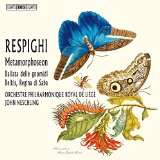|
Back
09/18/2015
Ottorino Respighi: Metamorphoseon – Ballata delle gnomidi – Belkis, Regina di Saba
Orchestre Philharmonique Royal de Liège, John Neschling (Conductor)
Recording: Salle philharmonique, Liège, Belgium (June 2014) – 72’ 15
BIS Recordings # BIS-2130 SACD – Booklet in English, German and French

   
Late 18th century Baroque was only one of many idiomatic styles Ottorino Respighi used inside his music. While the ‘Roman Trilogy’ best establishes the composer’s long lasting legacy, this BIS Recording cherry-picks esoteric selections, finely representing Respighi’s orientalism, impressionism and neoclassical approaches. Grand-nephew of Arnold Schoenberg and Arthur Bodanzky, John Neschling flavors the music well while helping to exemplify the variety of structure and functionality. Gracefully and thoughtfully placed on the CD cover, Maria Sybilla Merian’s lucid watercolor not only aptly entrees the first work, Metamorphoseon, but also broadens this musical metaphor inside the subsequent pieces.
Respighi’s Metamorphoseon (1930) flutters about with twelve illusory ‘mode’ variations. Subtle continuity is buried within to develop extensions for individuality. Liège Philharmonic’s remarks reminisce of Vaughan Williams’ moodiness (“Tema”) which carries us into lighter retreats (“Moderato non troppo.”) Respighi retains that occasional strident measure (“Molto allegro”) while stretching beyond with touches of mild plaintiveness (“Lento non troppo.”) The importance, however, is Respighi’s delight in spotlighting a specific musical instrument (“Cadenze” – Harp; “Lento” – Oboe.) Neschling’s reading of the music is lasting, particularly when we’re exposed to organ accompagnamento in the conclusive segment...a crowning touch of grandeur.
Although it only received eleven performances in its lifetime, the opulent ballet, Belkis, would fortunately be preserved through Respighi foresight by transforming the music into a concert suite (he planned two, but, alas, Respighi died before completing the second.) The fluidity is dramatic, converting the Biblical story into a plethora of sweeping images. Respighi credited his musical acumen to short-lived teachings of Rimsky-Korsakov. Without question, one can’t help but think of a pervasion of Scheherazade throughout the composition, and even strains of Glazunov’s Raymonda (Act II) are well within reach. Neschling depicts Belkis’ eroticism (“La danza di Balkis all’aurora”) through passionate whiffs amidst swells of forte phrasing. Akin to raucous rhythms of Le Sacre du printemps the climatic fourth movement (“Danza orgiastica”) labors and hampers slightly, ultimately proving ironically as erringly ‘anti-climactic.’
But for this reviewer, the most severely overlooked composition inside the Italian’s anthology is the symphonic poem, Ballata delle gnomidi (1920.) Wedged between The Fountains of Rome (1917) and The Pines of Rome (1924), this piece is a spectacle to the ear with its snowball of startling color and outrageous behavior. The Neschling interpretation usurps the music which dwells at times. There are strong reminders of Ravel’s Daphnis et Chloé (1912) in the front and back ends of Ballata delle gnomidi. Geoffrey Simon’s 2006 Cala release, though relentless with insistent and overburdened catatonic pacing, finds a contrarian Neschling signaling more cautiousness amidst dabbles of indelible clauses (the “Silence” movement is breathtaking.) This rendering, however, doesn’t necessarily wrest away the intended frenetic requisites: the music should rest peacefully on the tympanic membrane with a lining of measured shocking alarm (i.e. Strauss’ Salome) and horror. The end result accentuates Carlo Clausetti’s poem with fitting detail of luridness and sadistic sexual perversion. Neschling creates that vision.
BIS has a winner. Respighi fans will do well by having this recording even if solely based on the merits of having access to gnomidi.
Christie Grimstad
|